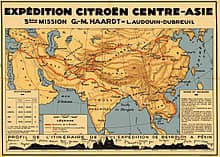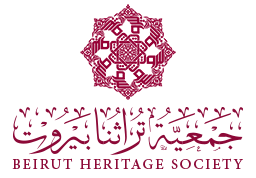(La Croisière Jaune)
د. سامي أ. حوري*
في عام 1931 ، قام مصنع السيارات آندريه ستروين Andre Citroen برعاية رحلة استكشافية عبر آسيا بقيادة جورج ماري هاردت Georges-Marie Haardt لعرض سيارات ذات النصف سلسلة (أي سلسلة في الخلف وعجلات في المقدمة) للسفر على الطرقات الوعرة عبر البلاد وتحسين التقدير الدولي للتجارة والعلوم والفنون. وكان Haardt قد قاد حملتين سابقتين لشركة Citroen في إفريقيا.
استغرق التحضير للرحلة الاستكشافية عامين. وشمل علماء الجيولوجيا وقساوسة ورسامين ومصورين سينمائيين وكتاب وميكانيكيين. كان مسار الرحلة المقترح من بيروت ، عبر روسيا من خلال صحراء غوبي إلى بكين ثم جنوباً إلى سايغون والعودة إلى بيروت، وبالتالي ربط مستعمرتين فرنسيتين. لكن السوفييت منعوا المرور عبر أراضيهم وتم تعديل خط سير الرحلة لدخول الصين عبر أفغانستان وسلسلة جبال بامير. نظرًا لصعوبة المسار ، تقرر تقسيم الفريق إلى مجموعتين: مجموعة بامير التي تبدأ في بيروت ومجموعة الصين التي تبدأ في بكين حيث ترتبط المجموعتان شمال بامير وتعودان إلى بكين معًا.
حطت مجموعة بامير في بيروت في 4 أبريل 1931 وسافرت عبر الصحراء السورية إلى بغداد. دخلت بلاد فارس ، وعبرت السهول الشمالية للهند البريطانية حيث بدأ البنزين في التبخر بسبب الحرارة الشديدة ثم تم تفكيك السيارات ونقلها بمساعدة الحمالين المحليين وخيولهم لتسلق جبال الهيمالايا. وفي النهاية تم التخلي عن السيارات ، واستمرت الحملة على ظهور الخيل بسبب الثلوج الكثيفة والممرات الضيقة.



بدأت مجموعة الصين في بكين ، ولكن تم احتجازها بعد ذلك في مقاطعة سينكيانغ لمدة شهرين بسبب الاشتباه المحلي في وجود غربيين. في النهاية تم إطلاق سراحهم ، واجتمعت المجموعتان في 27 أكتوبر ودخلتا بيكين في 12 فبراير 1932. بعد إقامتهم في بكين ، عانى Haardt من التهاب رئوي وتوفي في النهاية في هونغ كونغ ، وعند هذه النقطة تم التخلي عن الرحلة الاستكشافية دون إكمال رحلة العودة من بيكين الى بيروت.
ساهمت الرحلة الاستكشافية في إفلاس شركة Citroen في عام 1935. ومن الناحية الإيجابية ، زادت الاتصالات بين الشرق والغرب ، والتقطت صورًا وأفلامًا مسجلة لثقافات محلية مختلفة ، وعززت فهم الجيولوجيا المحلية وعلم النبات وعلم الأحياء و علم الآثار ، بالإضافة إلى خلق النوايا الحسنة من خلال المدفوعات النقدية والهدايا المقدمة إلى الأديرة المحلية ومع قيام أطباء البعثة بعلاج السكان المحليين الذين التقوا بهم في الطريق.
From Beirut to Beijing: The Yellow Expedition of 1931-32 (La Croisière Jaune).
In 1931, automobile manufacturer Andre Citroen sponsored an expedition across Asia led by Georges-Marie Haardt to showcase half-track cars for rugged cross-country travel and improve international appreciation for trade, science and the arts. Haardt had led two previous expeditions for Citroen in Africa.
Preparation for the expedition took two years. It included geologists, priests, painters, cinematographers, writers and mechanics. The proposed itinerary was from Beirut, through Russia, across the Gobi desert to Beijing then south to Saigon and back to Beirut, thereby linking two French colonies. The Soviets however blocked access through their territories and the itinerary was modified to enter China through Afghanistan and the Pamir mountain range. Given the difficulty of the route, it was decided to split the team into two groups: The Pamir group starting in Beirut and the China group starting in Beijing. The two groups would link up north of the Pamirs and return to Beijing together.
The Pamir Group landed in Beirut on April 4th, 1931 and drove through the Syrian desert to Baghdad. They entered Persia, crossed the northern plains of British India where gasoline began to vaporize due to the intense heat and then the cars were disassembled and hauled with the assistance of local porters and horses for the climb up the Himalayas. Eventually the track cars were abandoned, and the party continued on horseback due to heavy snow and narrow paths.
The China group started off in Beijing, but was then detained in Sinkiang province for two months due to local suspicion of Westerners. Eventually they were released, and the two groups met on October 27th entering Beijing on February 12th 1932. After their stay at Beijing, Haardt suffered from Pneumonia and eventually died in Hong Kong at which point the expedition was abandoned without completing the return leg from Beijing to Beirut.
The cost of the expedition was one of the contributors to Citroen’s bankruptcy in 1935. On the positive side however it increased communication between east and west, captured photographs and recorded movies of various local cultures, enhanced the understanding of local geology, botany, biology and archaeology, created goodwill through cash payments and gifts made to local monasteries and with expedition doctors treating locals they met on the way.
Information sourced from various web resources, including Citroen Communications and Encyclopedia.com
________
*باحث/ صديق جمعية تراثنا بيروت

